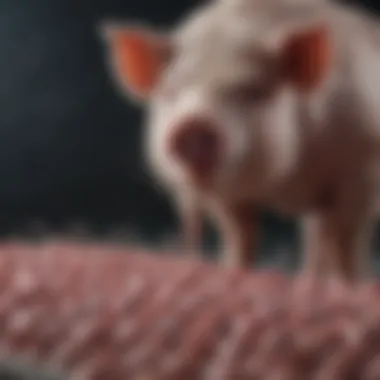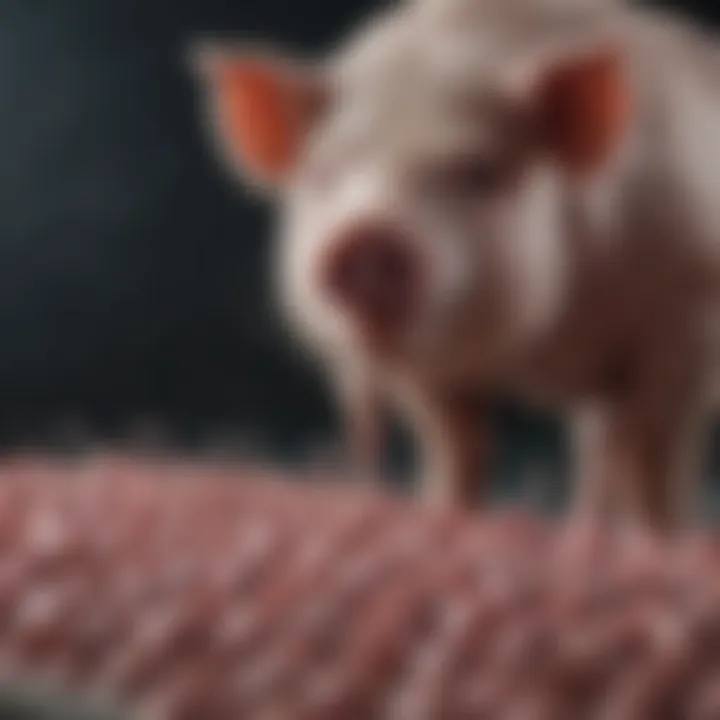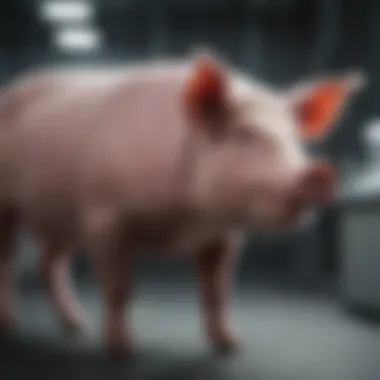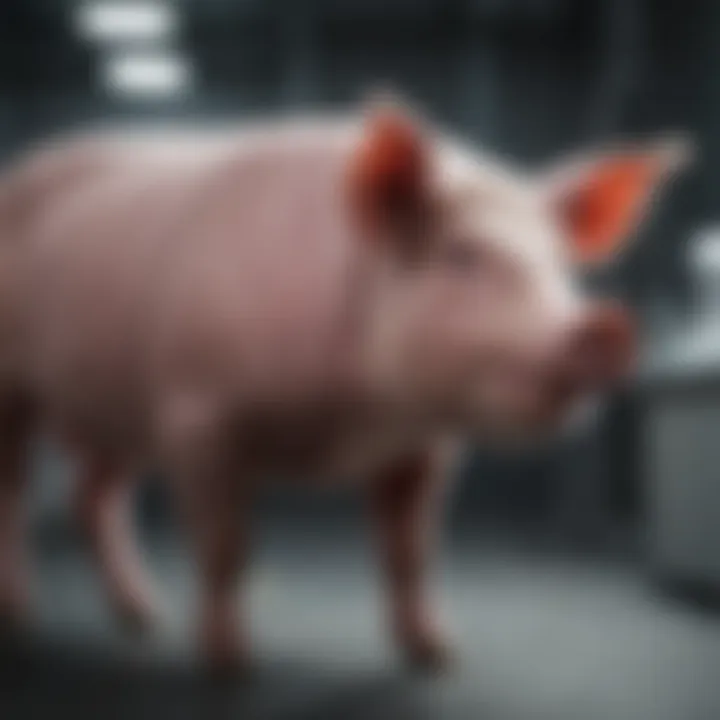Circo Virus Vaccination in Swine: A Detailed Overview


Intro
Circo virus, although a familiar term in veterinary science, often gets lost in the shuffle when discussing your typical farm animals. Recent advancements in science, especially concerning vaccinations, shed light on its potential impact. For those who work with or study swine, understanding this virus is a must. It not only bears implications for animal health but also touches on the larger issue of agricultural sustainability.
Despite the complex nature of this topic, the core issues tend to boil down to a few key aspects, primarily the virus’s biology, the variety of vaccines, and the implications of having effective immunization strategies. With the swine industry growing in economic significance, keeping our finger on the pulse of vaccination developments fosters a robust approach to safeguarding livestock.
Research Overview
In exploring the nuances of Circo virus and its vaccination, one quickly realizes that there's plenty to unpack. The following sections aim to encapsulate some crucial areas of research that outline why this topic matters.
Summary of Key Findings
Over the years, scientists have conducted numerous studies delving into the behavior of Circo virus in swine populations. Some of the findings point out the following:
- Circo virus is linked to several diseases, notably Porcine Circovirus Associated Diseases (PCVAD), leading to significant health concerns in swine.
- Implementing vaccination protocols has been shown to reduce instances of these diseases, thereby enhancing productivity and animal welfare.
- Recent developments in vaccine technology have focused on increasing efficacy while minimizing the potential adverse effects on swine health.
This accumulation of knowledge advances our understanding of how the disease interacts with livestock, affecting not just the individual animals but also impacting larger agricultural systems.
Relevance to Current Scientific Discussions
As discussions surrounding animal health continue to evolve, Circo virus research finds itself often at the forefront, particularly due to its implications on biosecurity. The interconnectivity of farm practices and disease management is more critical now than ever. Thus, the intersection of Circo virus vaccination and swine health becomes a focal point in:
- Addressing global food security concerns
- Ensuring economic stability in the livestock market
- Promoting responsible agricultural practices that consider both animal welfare and environmental sustainability.
Ultimately, understanding these factors not only benefits the scientific community but also provides crucial information to farmers, veterinarians, and policymakers alike.
Foreword to Circo Virus
The exploration of Circo virus vaccination is essential for understanding how this virus affects swine populations globally. Circo virus, particularly Porcine Circovirus, has stirred significant concern among pig farmers due to its role in various diseases that compromise animal health and productivity. Prioritizing vaccination as a preventive measure is crucial for maintaining the health of swine herds and, by extension, the agricultural economy. This introductory section sets the stage for an in-depth discussion about the challenges posed by Circo virus, making apparent the significance of vaccination in the broader context of livestock management.
Historical Context
Understanding the historical backdrop of Circo virus is important for grasping its current implications on swine health. Initially identified in the late 20th century, the virus was largely overlooked until its association with severe health issues in pigs became evident. Research from the 1990s unveiled that Porcine Circovirus can lead to conditions such as Postweaning Multi-systemic Wasting Syndrome (PMWS). As the years rolled by, we saw varying degrees of outbreaks across different regions, each necessitating a reevaluation of swine health management practices. With these past experiences in mind, one can comprehend how critical it is to keep updated with vaccination strategies that have evolved in response to this virus.
Geographical Distribution
The geographical footprint of Circo virus is as vast as it is concerning. Originally reported in North America and Europe, it has made its way into swine populations across Asia and other parts of the globe. The spread of the virus is influenced by various factors, including animal movement, farming practices, and the integration of international livestock markets. For instance, Southeast Asia has grappled with significant outbreaks that put local authorities on high alert.
It's crucial to remember that geographical distribution doesn’t just map out an area, but it also illustrates the potential risk factors and the diverse challenges encountered in vaccination efforts. Different climates and farming conditions lead to variances in how the virus behaves and how effective vaccination can be across regions. The interconnectivity of the global agricultural landscape implies that understanding these geographical dynamics is vital in formulating effective vaccination protocols and managing public health risks.
Biology of Circo Virus
Understanding the biology of Circo virus is crucial for tackling its impact on swine health and developing effective vaccination strategies. The virulence and transmission dynamics are rooted in its structural makeup and replication mechanisms. Hence, a thorough comprehension of these elements is vital not only for specialists in veterinary science but also for swine producers looking to ensure the wellbeing of their livestock and maximize productivity.
Structural Characteristics
The structural characteristics of Circo virus are fascinating and critical to its infectious nature. At a basic level, it is a small, single-stranded DNA virus, belonging to the family Circoviridae. The virion is typically 17 to 20 nm in diameter, encapsulated by a sturdy protein coat known as a capsid. This capsid is composed of a single major protein, which has been observed to undergo conformational changes during the infection process.
A noteworthy feature is its robustness against environmental conditions. Unlike many other viruses, Circo virus can withstand a range of temperatures and pH levels, making it particularly resilient in various farming conditions. This resilience not only affects its transmission within swine populations but also highlights the need for stringent biosecurity practices to limit its spread.
Moreover, the genetic structure of Circo virus allows it to evolve and adapt. Mutations can occur that may influence its pathogenicity, affecting the success of vaccination efforts. A keen understanding of these characteristics is paramount, as it will inform vaccine development and monitoring practices.
"The enduring nature of Circo virus presents a constant challenge for swine health management, underscoring the necessity for ongoing research and adaptation in vaccination strategies."
Replication Mechanism


The replication mechanism of Circo virus is a marvel of viral biology. After penetrating the porcine cells, the virus attaches primarily to the cell surfaces via specific receptors. Once inside, it utilizes the host's cellular machinery to replicate its genetic material. This process typically unfolds in the nucleus, which is unlike some other viruses that replicate in the cytoplasm.
- Initiation: The infection begins when the viral DNA genome is released into the nucleus of the host cell.
- Transcription and Translation: The host’s RNA polymerase transforms the viral DNA into mRNA, which in turn is translated into proteins that compactly form new viral particles.
- Assembly: These proteins and the replicated viral genome assemble to create new virions, ready to be released from the cell.
- Release: Finally, the newly formed viral particles exit the host cell, a process that can cause cell lysis and leads to further infection of neighboring cells.
This complex dance of infection and replication underscores the need for innovative approaches in vaccine development that could disrupt these processes. Targeting specific stages of replication holds promise in generating more effective immunization strategies.
In summary, grasping the intricacies of Circo virus biology equips stakeholders with the insight needed to combat its effects on swine populations. Understanding the virus's structure and replication mechanisms lays the groundwork for creating targeted and effective vaccination protocols.
Impact of Circo Virus on Swine
The effects of the Circo virus on swine go beyond mere clinical observations; they weave into the very fabric of swine production and agriculture. Understanding this impact becomes vital for those involved in animal husbandry. Circo virus is a silent threat, a lowkey but significant disruptor in the swine industry, leading to severe economic and health repercussions.
Clinical Symptoms
When we speak of the clinical symptoms associated with Circo virus infection, it’s crucial to underscore the variability in manifestations among different pig populations. Primarily, the disease manifests itself in post-weaning multi-systemic wasting syndrome (PMWS). This condition is characterized by weight loss, lethargy, and sometimes skin lesions that hint at an underlying infection. Affected pigs often show stunted growth, which can be a red flag for farmers and vets alike.
Additionally, respiratory illness can accompany Circo virus, further complicating the clinical picture. Multiplying these symptoms can lead to a compromised immune system, making pigs more susceptible to other infections, thus presenting an even bigger hurdle during the rearing process.
On many farms, these symptoms often lead to increased mortality rates. The issue isn’t just about treating the sick animals; it’s about the overall herd health and productivity. Farmers must notice subtleties in the pigs’ behaviors or the rise in scrapie, and often, it takes a trained eye to catch these ominous signs early.
"The symptoms may be subtle at first, but ignoring them can lead to devastating losses."
Epidemiology and Transmission
The spread of Circo virus is a complex topic, as it involves various transmission routes and environmental factors. Initially, the virus can be transmitted vertically from the sow to the piglets during birth or nursing periods. This aspect underscores the importance of maternal health and vaccination strategies even before the piglets are born.
There’s also evidence pointing towards horizontal transmission, where the disease spreads through contact with infected individuals. This can happen in various ways: shared equipment, contaminated feed, or even through aerosols in densely populated pig housing. Some strains are more virulent, heightening the risk of outbreaks in herds, particularly where biosecurity measures aren’t strictly observed.
Highlighting the epidemiological aspect, some studies have noticed a seasonal pattern to the outbreaks, suggesting that environmental changes play a part in transmission dynamics. For instance, higher humidity or crowded conditions can exacerbate the spread. Farmers observing an uptick in disease may need to reassess their housing and management practices.
Vaccination Strategies Against Circo Virus
Vaccination strategies against Circo virus are crucial in managing the impact of the virus on swine health and productivity. As the swine industry grows and demand for healthy livestock increases, understanding effective vaccination methods becomes paramount. The strategies not only help control outbreaks but they also enhance the overall health of pig populations and improve farming economics.
Types of Vaccines Available
Attenuated Vaccines
Attenuated vaccines involve a weakened form of the virus, which still triggers an immune response in pigs without causing the disease itself. This type of vaccine is often a first choice in swine vaccination due to its robust immunity building. Unlike inactivated vaccines where the virus is killed, attenuated vaccines can stimulate a more comprehensive and longer-lasting immune response.
One unique feature of these vaccines is that they tend to require fewer doses compared to others, meaning farmers can save on administration costs. However, a notable disadvantage is that there is a slight risk of reversion to virulence in rare cases, which could potentially affect the herd if not managed properly.
Inactivated Vaccines
In contrast, inactivated vaccines use a virus that has been killed, ensuring that there's no chance of the disease developing. While these vaccines generally require multiple doses to maintain immunity, their safety profile is a significant advantage. Farmers can administer them without the fear of the vaccine causing an outbreak.
Furthermore, inactivated vaccines can be effective in environments where herd immunity is already established. One challenge with inactivated vaccines is having a less potent immune reaction due to the inactive nature of the antigen, which might result in shorter-lived immunity that necessitates booster shots.
Subunit Vaccines
Subunit vaccines are another innovative approach in the fight against Circo virus. These vaccines use only specific pieces of the virus, typically proteins, to provoke an immune response without introducing the whole pathogen. They can offer a great safety profile as they do not use live pathogens.
The key benefit of subunit vaccines is that they can be produced more consistently and tailored to specific strains of the virus, responding effectively to particular challenges within the herd. However, they may require adjunct additives to enhance immune response, which can lead to variable reactions among swine, making careful monitoring important.
Vaccination Protocols


Effective vaccination protocols are vital in ensuring the success of any vaccination strategy. These protocols often consider the timing of vaccine administration, herd dynamics, and environmental factors that could affect vaccine efficacy. For example, piglets may receive their initial vaccinations within a few weeks after birth, usually at 3-6 weeks, true to the protocols structured around their specific developmental stages.
Moreover, revisiting and updating protocols according to ongoing research and emerging strains of Circo virus ensures maximum protection. Regular monitoring and adjustments are key components to maintaining a robust vaccination regimen in the herd.
Efficacy and Safety of Vaccines
When evaluating the efficacy and safety of vaccines, it is critical to consider the overall impact on swine health and production. Studies show that well-administered vaccines in controlled environments increase survival rates and decrease the prevalence of clinical symptoms associated with Circo virus. Safety is also an immeasurable aspect piloting vaccine success; unexpected adverse events can have significant ramifications for both the animals and the economic stability of the farms.
Being aware of the specific characteristics of each type of vaccine helps facilitate informed choices and ultimately supports the health and productivity of the swine population.
Regulatory Aspects of Circo Virus Vaccination
The regulatory landscape surrounding Circo virus vaccination plays a crucial role in the management and control of this pathogen in swine populations. Understanding these regulations is not just about compliance, but it also affects vaccine availability, safety, and efficacy, which has significant implications for the health of livestock and, by extension, agricultural practices. Regulatory frameworks ensure that vaccines meet stringent safety standards, which protect the animals and the people handling them. This oversight can boost farmer confidence in vaccination programs and help bolster public trust in agricultural products.
Government Regulations
Government regulations regarding Circo virus vaccinations are primarily established to safeguard animal health and promote biosecurity. These regulations often include extensive lab testing and field trials prior to vaccine approval. Different countries may have varied approaches, but key elements generally include:
- Vaccine Testing Requirements: Vaccines must undergo rigorous testing to determine their safety and effectiveness. This typically involves several phases, from laboratory assessments to clinical trials in target populations.
- Licensing and Approval Processes: Once testing is complete, vaccine manufacturers must submit extensive documentation to regulatory bodies, such as the USDA in the United States or the EMA in Europe, for review and approval. This process can take significant time, emphasizing the importance of thorough evaluation.
- Post-Approval Monitoring: After a vaccine is approved, regulatory agencies often mandate ongoing monitoring to watch for unexpected side effects or long-term efficacy issues. This attention ensures any concerns can be swiftly addressed.
These regulations often dictate specific vaccination protocols that veterinarians must follow. For example, a protocol might recommend vaccinating sows before they farrow to protect both them and the piglets early in life, thus minimizing the spread of the virus.
Certification Processes
The certification processes for vaccines against Circo virus are also vital for establishing a reliable system of vaccine distribution. Without these procedures, the entire vaccination campaign could face suspicion over safety and efficacy. Certification can be broken down into several key components:
- Manufacturer Compliance: Vaccine manufacturers must adhere to documented standards, proving their facilities and production methods are capable of consistently producing high-quality products.
- Quality Assurance Testing: This component involves sampling vaccine lots for potency and safety before approving them for release to the market. Such testing ensures that veterinary practices are administering effective vaccinations to livestock.
- Traceability Requirements: Veterinarians and farmers often must document the vaccination status of their animals, ensuring compliance with both local regulations and broader biosecurity protocols. This traceability can be critical during disease outbreaks, allowing swift action to be taken.
In summary, the regulatory aspects of Circo virus vaccination not only shape the landscape for vaccine production but also contribute to maintaining the health of livestock and enhancing agricultural sustainability. They play a pivotal role in mitigating the risks associated with swine diseases, ensuring a safer food supply, and fostering confidence among agricultural stakeholders.
Research and Developments in Circo Virus Vaccination
The ongoing progress in the field of Circo virus vaccination is pivotal to the health and productivity of swine populations. Addressing Circo virus is not just a matter of disease prevention; it is about ensuring the viability and sustainability of livestock farming practices. Advances in research lead to enhanced vaccines and better management strategies, indicating a direct response to the ever-evolving challenges faced by farmers and producers.
When analyzing the implications of new findings, one must recognize both the potential benefits and the necessary considerations which come with them. New vaccine formulations, breakthroughs in delivery methods, and enhanced monitoring protocols reflect a drive to minimize risks associated with Circo virus infection. As knowledge deepens in this realm, the likelihood of achieving herd immunity will increase, ultimately promoting healthier swine populations and more stable agricultural sectors.
"Continued research is essential. Only by staying one step ahead can we protect livestock from emerging threats."
Recent Findings
Recent discoveries in the understanding of Circo virus behavior and its interaction with the host have provided significant insights. Studies have shown that some swine populations exhibit varying levels of immunity depending on genetic factors, suggesting that breeding for resilient animals could be beneficial. Furthermore, researchers are finding that vaccination timing plays a key role in achieving optimal efficacy. For example, administering vaccines at earlier stages of growth may offer enhanced protection against severe outbreaks, aligning with findings that the immune system of younger pigs is particularly adaptable.
Moreover, improvements in diagnostic techniques are paving the way for better tracking of virus transmission within herds. Utilizing polymerase chain reaction (PCR) tests has significantly increased the speed and accuracy of identifying infected animals. This timely detection is crucial for implementing effective quarantine measures and minimizing the spread of Circo virus.
Innovative Approaches
As the landscape of swine health unfolds, innovative techniques are becoming increasingly prominent. One such advancement is the exploration of mRNA vaccine technology, which has gained traction beyond human health. This approach might allow swine vaccines to induce a more robust and rapid immune response. Unlike traditional vaccines, this new technology doesn’t use live pathogens but instead instructs the cells to generate a harmless piece of the virus, thereby triggering an immune reaction that prepares the animal for future encounters with the actual virus.
In addition, the integration of farm management software is on the rise. These platforms enable farmers to track health parameters and vaccination schedules closely. By employing data analytics, producers can now predict potential outbreaks and response strategies, making farming decisions on a more informed basis. This holistic perspective is leading to a paradigm shift in how swine health is managed, emphasizing preventative care as much as treatment.
New vaccine delivery systems, such as intranasal administration, also emerge as promising avenues. This method could simplify the vaccination process, reduce stress on animals, and ensure a more even distribution of the vaccine in the respiratory system, which is often the entry point for viruses. The advancement of these innovative approaches brings renewed hope and potential effectiveness in combating the challenges posed by Circo virus in swine populations.
Challenges in Circo Virus Management
The management of Circo virus in swine presents several challenges that affect livestock health and agricultural productivity. Understanding these challenges is crucial for anyone involved in the swine industry, whether they are farmers, veterinarians, or researchers. These issues not only impact the individual farms but also influence the broader agricultural economy and food supply chain.


Resistance to Vaccination
Vaccination resistance is a thorn in the side of swine health management programs. When a substantial portion of pigs does not respond to vaccination, it can lead to outbreaks and a spike in the prevalence of diseases. The reasons for resistance can vary widely, including:
- Genetic Factors: Some swine possess genetic predispositions that might influence their response to vaccines.
- Viral Variants: Mutations in the Circo virus may render existing vaccines less effective, signaling a need for ongoing updates in vaccine formulations.
- Stress Factors: Environmental stresses such as poor housing conditions, inadequate nutrition, or transportation can impair the immune response, making vaccines less effective.
Thus, addressing vaccination resistance involves a multifaceted approach that requires continuous monitoring of both pig health and the circulating strains of Circo virus.
Economic Implications
The economic implications of Circo virus management cannot be overstated. Disease outbreaks linked to this virus lead to significant costs for producers. For example:
- Direct Costs: This includes the expenses related to veterinary care, treatment methods, and any necessary vaccines.
- Indirect Costs: Reduced productivity affects meat quality, growth rates, and overall herd health, which translates into lost income for farmers.
- Market Impact: Outbreaks affect market perceptions, which may limit sales or decrease market value for affected farms.
Furthermore, there’s a ripple effect. The impacts extend beyond individual farms and can influence supply chains, raise consumer prices, and challenge the stability of pork production on a national scale.
"Effective management of Circo virus, including timely vaccinations, not only safeguards a farm's productivity but is vital for bolstering the entire agricultural economy."
To sum up, the challenges presented by Circo virus management are complex and multifaceted. Tackling resistance to vaccination and understanding the economic implications are just two facets of a broader, ongoing struggle within swine health management. As the industry evolves, innovative strategies are crucial in mitigating these challenges and ensuring a stable future for swine production.
Future Directions in Swine Vaccination Research
In light of the pressing challenges surrounding Circo virus and its impacts on swine populations, the future of swine vaccination research emerges as a crucial area of focus. With swine health linked closely to economic stability in agriculture, exploring innovative vaccine solutions not only addresses immediate health concerns but also contributes to the long-term sustainability of the industry. As researchers and industry experts delve deeper, the forthcoming advancements may redefine vaccination protocols, enhance efficacy rates, and ultimately protect livestock better than ever before.
Potential Advances in Vaccine Technology
One of the most promising avenues lies in the realm of vaccine technology. Ongoing research is highlighting several potential advances that could lead to more effective and safer vaccines for swine. Notably, here are some emerging technologies being considered:
- mRNA Vaccines: Much like the successful approach seen in human vaccinations, mRNA technology may help tailor a vaccine that produces a robust immune response against Circo virus without the risk of causing the disease itself.
- Vaccine Delivery Systems: Advances in delivery systems reduce stress on animals during vaccinations. For instance, oral or intranasal vaccines are being explored to provide more user-friendly methods that can increase compliance rates in herds.
- Adjuvants: The development of novel adjuvants that stabilize vaccine formulations could enhance their effectiveness, helping the immune system recognize and attack Circo virus more swiftly and effectively.
Adopting these innovative solutions could accelerate the timeline of bringing new vaccines to market, ultimately protecting swine health more efficiently.
Global Trends in Animal Health
At the same time, global trends in animal health significantly influence the future of vaccination research. Changes in legislation, increased attention on animal welfare, and the economic implications of swine health drive new approaches. An important aspect to consider includes:
- Regulatory Framework Changes: There is ongoing evolution in how governments regulate vaccines in agriculture. These changes affect research priorities and funding, including global cooperation to combat diseases affecting swine.
- Sustainability Practices: As consumer preferences shift toward sustainably sourced meat, there’s growing pressure to enhance animal health through effective vaccination. Research that focuses on reducing antibiotic use by improving animal immunity through vaccination aligns with current market demands.
- International Collaboration: The interconnectedness of global agriculture highlights the need for shared research findings and collaborative efforts across borders. By pooling resources and knowledge, the industry can tackle swine health challenges more effectively than individual countries might on their own.
"Investing in vaccine research today is crucial for swine health tomorrow."
Epilogue
Vaccination stands as a cornerstone in managing swine health, especially when considering the challenges posed by Circo virus. The implications of implementing a comprehensive vaccination program cannot be overstated. It not only enhances the overall well-being of the livestock but also ensures the sustainability of farming practices.
Significance of Vaccination in Swine Health
Vaccination is crucial for several reasons. First, it significantly reduces the incidence of Circo virus infections, which can lead to costly outbreaks that affect productivity and animal welfare. Healthy swine are essential for the agricultural economy, and vaccination acts as a barrier against disease spread, safeguarding herd integrity.
Moreover, vaccination influences growth rates, feed efficiency, and overall meat quality. When pigs are protected from diseases, they tend to exhibit better growth patterns, leading to improved yield for farmers. This not only benefits producers financially but also meets consumer demand for healthy pork products.
In addition, the increased awareness and adoption of vaccination protocols encourage better biosecurity measures. Farmers become more vigilant about herd management and hygiene, ultimately raising the health standards across swine operations.
Call to Action for Research and Development
There’s no denying that the field of swine vaccination needs continuous research and development. The evolution of Circo virus and its ability to adapt calls for novel vaccine strategies that cater to emerging threats. It's a dynamic situation, and researchers must prioritize collaborative efforts to stay ahead of the curve.
Investing in research will lead to the development of more effective vaccines, possibly incorporating second-generation technologies that enhance the immune response. This is essential in ensuring that swine vaccination remains relevant and effective against evolving strains of the virus.
Furthermore, funding initiatives that promote innovation in vaccine delivery methods could improve distribution and efficacy. Streamlined protocols could make it easier for farmers to incorporate vaccinations into their routines, making their lives just a bit easier.
To wrap it up, the importance of understanding Circo virus vaccination goes beyond mere prevention; it’s about ensuring a sustainable agricultural future. With more research and commitment to developing effective solutions, we can enhance the resilience of swine health and, in turn, support the entire agricultural system.



